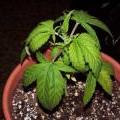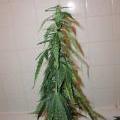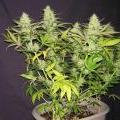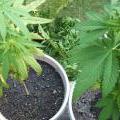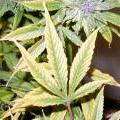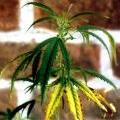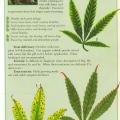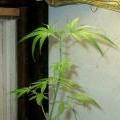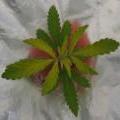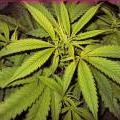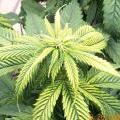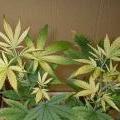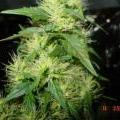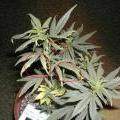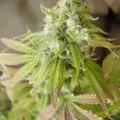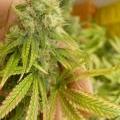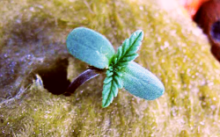You are hereMarijuana Problems & Symptoms - Old version, please visit the new page!
Marijuana Problems & Symptoms - Old version, please visit the new page!
Please visit the updated version of this page, with more pictures, information and personalized help!
http://www.growweedeasy.com/7-step-remedy
 This page will attempt to help you diagnose any problems you are having with your plant. There are many things that could unexpectedly pop up when first growing marijuana, but if you pay close attention to your plants for your first couple of grows, you will be able to fix almost any problem before it ruins your crop. After a few test runs under your belt, growing marijuana starts to seem easy and straightforward.
This page will attempt to help you diagnose any problems you are having with your plant. There are many things that could unexpectedly pop up when first growing marijuana, but if you pay close attention to your plants for your first couple of grows, you will be able to fix almost any problem before it ruins your crop. After a few test runs under your belt, growing marijuana starts to seem easy and straightforward.
I have tried to make the info on this page easy to navigate and understand. If you have any pictures or information which you would like to see added to this page, please don't hesitate to contact me!
Prevent Most Problems With Your Marijuana Grow
Almost all problems with your marijuana plant can be prevented by following these five rules:
- Give your plants a balanced set of nutrients which are appropriate for both marijuana plants and your growing medium. Remember to always start with a fraction of the recommended nutrients, and work your way up to full strength slowly.
- Maintain an appropriate pH level in order to prevent nutrition deficiencies. Your cannabis plant cannot access certian nutrients through their root system if the pH level in the root zone is off. As a result, cannabis plants may start showing signs of nutrition deficiencies even when the nutrients are available in the growing medium. A good general guide is with soil to maintain a pH in the range of 6.0-7.0 (try to mostly stick around 6.5-7.0), and for hydroponics to maintain a pH in the range of 5.5 - 6.3. This article has more information about pH and shows you how to check and adjust the pH of your water (it's easy!).
- Make sure your plants have plenty of water without drowning them in it. There is more information about how often to water your plants below. Even when cannabis plants are grown directly in water, there must be an airstone to disolve oxygen in the water or your plants with 'drown' from lack of oxygen.
- Make sure that your plants are kept in a climate that mimics their preferred natural habitat. Indoor marijuana plants need fresh air/ventilation and like temperatures around 75° F (23° C) plus or minus 10° F (6° C). This is a good range to shoot for as an indoor grower. However, most outdoor plants as well as some indoor plants can tolerate temperatures outside that range. A good rule of thumb is if your grow area is uncomfortable for you spend time in, it's probably uncomfortable for your plants.
- If you are experiencing a problem with your plant and can't seem to figure out the cause, your first recovery step is to thoroughly flush the whole system with new, plain pH'ed water. Some people prefer to flush with water that has 1/4 strength nutrients. After you've thoroughly flushed the system, wait a week and observe your plant to see if the symptoms improve. You need to realize that heavily damaged leaves will not repair themselves. What you are looking for is the new growth on the plant. If the new growth on the plant is still displaying the same problems as before, then proceed to the summary of issues below.
What does it mean to flush your plant? If your plant is growing in a pot or container, you want to keep giving the plant water until it seems like the majority of the water you are putting in is running clear out the bottom(about twice as much water as would fill the container). If you are growing hydroponically, you would want to replace all the water in the system with plain pH'ed water, or water with 1/4 nutrient strength.
If you've gone through the above check list and are still experiencing a problem with your cannabis plants, than read on! This article will try to cover the most common problems experienced by marijuana growers. I will attempt to try to put these in order from the most common to the least common:
Overwatering
Problem: Your plants leaves will start drooping if they've been overwatered or underwatered. If you've overwatered your plant, its leaves will be firm and curled down all the way to the stem of the leaf. You may also notice Chlorosis (Leaf Yellowing). Plants use their roots to get oxygen which is dissolved in water or oxygen in their grow medium. When you overwater a plant, its roots are sitting in stagnant water which no longer has any oxygen left. The reason your plants droop is because basically their roots are starving for oxygen.
Solution: The best thing you can do for overwatered plants is give them time without watering, and then start them off slowly until things seem back to normal. You can try to increase the temperature and airflow to help the water evaporate more quickly. You can also use a pencil to gently poke some air holes into the growing medium to provide extra aeration and oxygen to the roots.
For soil grows, you generally only want to water the plant when the soil feels dry if you press a finger in it. You can also use the "lift the pot" method described below (under Underwatering) to decide when to water your plants. For other growing mediums besides soil, your watering method will vary, but if your plants are drooping and you've been feeding them a lot of water, it's a good idea to cut back and see if that helps.
Underwatering
Problem: If your plant is drooping and you're sure you haven't overwatered it, than it might need more water. If you've been underwatering your plant, its leaves will look limp and lifeless.
Solution: While it can be good to let your plant dry out a bit after watering, you should always water the plant again before it's leaves start drooping. A good way to tell if a potted plant is ready to be watered is to pick it up and tell if it feels heavy or not. As plants use up all the water in their pot, it will start to get lighter. If you need something for comparison, you can get an extra pot and fill it with your growing medium. Now you can use this extra container for comparison with your potted plants as it represents the 'dry weight' of your growing medium. If you pick up a potted plant and its feels just slightly heavier than your dry pot, then you know it's time to water your plant. After a while you get a feel for how heavy your plants need to be and you may not even need the extra pot anymore.
Click here to see a time-lapse of an under-watered marijuana plant coming back to life.
1 picture taken every 75 minutes. Strain is Island Sweet Skunk. Used with permission.
Root Rot
Problem: Roots need water, but if they are exposed to water with bacteria they will start to rot. Roots that have been drowing in too much water without enough available oxygen are much more susceptable to problems. Healthy roots are white to cream-colored while roots affected by root rot are brownish and actually smell like they're rotting. Plants affected by root rot will spontaneously start losing their leaves, yellowing, drooping, and otherwise look like they're dying. You will also notice that affected plants will start drinking less water. If you notice these symptoms in your plant, then it can't hurt to try all the suggestions for stopping root rot.
It's important to notes that root damage is permanent. A recovering plant will be able to make new growth, but it's old infected roots will likely never recover. Root rot mostly affects hydroponic systems, but can also result from over watering your plants in soil or other medium. Basically anytime the roots are sitting in water, they are at risk of devloping root rot.
Solution: It can be tough to get rid of root rot and many people feel it's easier to just scrap the plant and start over. However, there are proven techniques that will cure your plant of root rot problems. In order to get rid of root rot successfully, you need to take a two pronged approach. You will need to treat the plant's root directly and you will also need change the plant's environment so that root rot no longer has a good place to grow. If you don't fix the environmental causes of root rot, then it will just keep coming back no matter what you do. Therefore, it's important to go through the below list and make sure you're covering all your bases to prevent a re-occurrence. It's also important to note that affected roots will likely never recover, just like how discolored leaves on the plant will never recover. What you're looking for is new, healthy white root growth.
How to prevent and treat root rot:
-
You will need to keep your grow area as clean as possible at all times to stop bacteria before it starts. Before you begin your grow, you should also thoroughly clean all grow-related items with white vinegar and water to kill all bacteria.
-
Some people like to add beneficial bacteria to their water to help prevent and treat root-related plant diseases and help make nutrients available to the plant. Some of the formulas available are Piranha, Aquashield, VooDoo Juice, Great White (Great White has great reviews, yet is obscenely expensive), Subculture B, Rooters, and Plant Savers. Most of these can be used with both hydro and soil grows. I personally recommend Subculture B because I've used it successfully to treat Root Rot (and by 'successul' I mean I was able to eventually harvest the buds). I've also heard many great things from other hydroponic growers about Aquashield, which is much cheaper than Subculture B. I plan on trying Aquashield with my next hydroponics grow if I have any occurence of root rot.
-
If you have a hydroponic system, it's a good idea to change your reservoir water regularly in order to prevent any one type of bacteria from overgrowing the whole reservoir. I personally recommend trying to change your water at least once a week. Regularly changing your water will also help your plants get better access to nutrients and the roots of the plant love that 10-15 minutes where they get access to the oxygen in the air (just don't ever let the roots get dry).
-
It is beneficial to try to get as much oxygen as possible disolved in your water. Therefore it's a good idea to buy a BIG air pump and big air stones for your hydroponic system. Root rot cannot thrive in an oxygen rich environment and your plant's roots love it.
-
Ensure that the temperature of the water never gets warmer than a comfortable room temperature. Warm water holds much less disolved oxygen than colder water and also provides the perfect environment for bacteria to grow. The maximum recommended temperature for the water in your reservoir is around 72°F (22°C). Trying to maintain water temps around 65°F - 68°F (18°C - 20°C) seems to be optimal for both plant growth and root rot prevention.
-
In a hydroponic system, ensure that any dead roots, dead leaves or other types of plant debris doesn't get into the reservoir because they will provide a breeding ground for bad bacteria as they start rotting.
-
Don't let any light get to your roots or reservoir water ever, as it provides heat and light which will promote the growth of bacteria.
-
SM-90 will also prevent and treat root rot, as well as help your plant's overall root health. It's made up of a few different types of oils that happen to kill many pathogens as well as make nutrients more available to your plant's roots. I also like to have SM-90 around because it will kill aphids, spider mites, and white powdery mold when used as a foliar spray. I personally feel that anyone who grows hydroponically should have some SM-90 around. I've heard that SM-90 will kill beneficial bacteria, so I don't use it if I'm adding Subculture B. I always use one or the other.
-
Some people recommend treating root rot with H2O2, also known as hydrogen peroxide. While adding hydrogen peroxide to your water will kill all bacteria including root rot, it is only effective in your system for 1-2 days since the H2O2 is quickly converted to oxygen and water. Therefore, if you use hydrogen peroxide as a treatment for root rot, you will need to treat your water daily to prevent re-occurances. If you want to kill all the bacteria in your water, I personally recommend getting SM-90 instead because it will remain effective in your water for at least a week. If you want to encourage good bacteria to grow, then don't either use SM-90 or hydrogen peroxide and get Subculture B or Aquashield instead.
Your plant can completely recover from root rot as long as you catch the problem early enough, so it's important to stay vigilent of root rot during your first couple of grows, expecially when growing with hydroponics.
Heat and Light Stress
Problem: Your plant can only withstand a certain amount of heat and light. After a certain point, your plant will start exhibiting signs of stress on the leaves near the sources of light and/or heat. Your leaves will get yellow or brown brown spotting and may appear generally burnt in places. The first two pictures are of heat stress, and the last picture shows a marijuana plant which is showing signs of light burn (too much light).
Solution: Find a way to lower the temperature and/or increase the circulation in the room if heat is the problem. If your plants are just getting too much light, try removing some of the lights or moving your lights further away from the plants.
Bugs and other Pests
Please click here for more information about pests/bugs and your marijuana grow.
Nutrition Problems
Most nutrient problems can be avoiding by maintaining a proper PH and feeding your plants a set of nutrients that are designed for both your grow medium and plants like marijuana. This article explains how to check and adjust the pH of your water (it's easy!) which will prevent most nutrient deficiencies.
However, if you've looked at the above issues and still can't figure out the problem, then please take a look at this list of nutrient problems and their symptoms.
The most important nutrients to Marijuana plant are Nitrogen (N) , Phosphorus (P), and Potassium(K). It is recommended that your plants also have access to the secondary nutrients, Calcium, Magnesium and Sulfur. Lastly, there are seven micro-nutrients which your plant likes but are much less likely to cause a nutrient deficiency. The seven mico-nutrients are Iron, Boron, Chlorine, Manganese, Copper, Zinc, and Molybdenum.
Too much nutrients (Nutrient Burn)
Problem: You may notice the tips of your plants showing signs of nutrient burn. If it only seems to be affecting the tips, then there's no need to worry, but if you start noticing the problem spread to the whole leaf, then you should immediately do something to treat your plant before there's more damage. Nutrient burn can also manifest itself as random spots around the edges of the leaves, or with leaf tips curling downwards.
Solution: Flush your system with plain, pH'ed water. Give your plants some time to recover, and start them with a fraction of the nutrients you were giving them before working your way up to more nutrients. Many nutrients come with instructions to feed your plant more nutrients than most plants actually need. It's good business for them if you use more nutrients. However, in my experience it's a good idea to view the feeding charts that come with nutrients as the maximum amount of nutrients and actually start with much less.
Problems with Primary Nutrients
Nitrogen deficiency
Problem: Nitrogen is important during the vegetative stage of your cannabis plants. As your plants start flowering, they will need lower amounts of nitrogen. A nitrogen deficiency will cause the older, lower leaves on your plant to start turning yellow and eventually die. It's relatively normal for your plant's leaves to start turning yellow towards the end of your flowering cycle as the plant becomes nitrogen deficient while it's creating its buds. However, if you notice your leaves turning yellow in the vegetative stage or in the beginning parts of the flowering stage, your plant may be experiencing a nitrogen deficiency which will need to be treated. The first picture is a plant in the vegetative stage which is experiencing the beginnings of a nitrogen deficiency. The second plant is showing signs of nitrogen deficiency late in flowering and is completely normal. The last picture is an infographic about nitrogen and your marijuana plant.
Solution: You can find many pre-mixed nutrients from the store which contain nitrogen or you could use nitrate of soda or organic fertilizer which are both good sources of nitrogen. Try supplementing your regular nutrients with a bit more nitrogen and see if the plant starts recovering.
Too Much Nitrogen (Nitrogen Toxicity)
Problem: Dark green leaves, weak stems, and overall slow growth. Leaves may eventually turn brown and fall off.
Solution: Reduce the amount of nitrogen that is being fed to the plants.
Phosphorus Deficiency
Problem: Phosphorus aids in root growth and overall health of the plant and is especially essential when the plant is in flowering. A plant which is deficient in phosphorus will have slow, stunted growth and may exhibit red or purplish stems. New leaves are small, and blueish-green with blotches. If there is a major deficiency, the leaves may exhibit dark gray or purplish splotches. The last picture below is an info-graphic with more information about phosphorus and your marijuana plant.
Solution: Check the pH and flush system. An excess of Fe and Zn may cause a phosphorus deficiency. If you've tried everything else, then you may try adding a bit more phosphorus to your feeding schedule and see if that helps clear up the problem.
Too Much Phosphorus (Phosphorus Toxicity)
Problem: Marijuana loves Phosphorus and is unlikely to show signs of toxicity. It takes several weeks for a plant to start showing signs, and will mostly show signs of other nutrient deficiencies as the phosphorus locks up other nutrients. Click picture below for more information about phosphorus and your marijuana plant.
Solution: If you maintain a proper pH, it's very unlikely you will overdose your plant with phosphorus. If you suspect your plant may have had too much phosphorus, the best thing to do is flush the plant with lots of clean, pH'd water at half nutrient levels.
Potassium Deficiency
Problem: Older leaves turn yellow then start getting dark, scorched lesions around the edges of the leaves. Plants may stretch and stems may become weak. The symptoms are very similar to an iron deficiency except the tips of the leaves curl as the edges burn and die. The last picture below has some more information about the potassium requirements of your marijuana plant.
Solution: Potassium isn't absorbed properly when there is too much calcium or nitrogen in the system. Check the pH of your water, and flush your whole system with water that contains half the normal amount of nutrients and see if your plant starts showing signs of improvement.
Problems with Secondary Nutrients
Calcium Deficiency
Problem: A Calcium deficiency manifests itself first in new growth, with new leaves appearing small and distorted with curled tips. Leaves will also display dead spots, crinkling, spotting, or small brown spots. The insides of the plant and well as flowers/bud may show signs of decay. Roots may show bacteria and dying off or be under developed.
Solution: If the pH is off, then the plant cannot properly absorb the calcium around the roots so the first step is to ensure that you have the correct pH for your growth medium. New growth should start looking healthy once the calcium deficiency has cleared up.
Magnesium Deficiency
Problem: The edges of the leaves may become yellow or bright green and may start feeling crispy to the touch. The light green or yellow coloring may also effect the veins of the leaves.
Solution: It is very important to maintain a proper pH in order to avoid a magnesium deficiency. Adding more magnesium to a system when there is a pH lock-out will only make the situation worse because the plant will not be able to absorb any magnesium until the pH has been corrected. Flush the system with properly pH'ed water that contains a full set of proper nutrients and see if the new growth starts looking healthier.
Sulfur Deficiency
Problem: A sulfur deficiency will manifest itself as all-over chlorosis (yellowing of leaves) starting with the oldest leaves and may look like a nitrogen deficiency at first. The parts that are underneath the leaves may take on a distinctive pinkish red or orange color. The buds on a flowering plant may start dying off. Unlike other deficiencies that cause chlorosis, a sulfur deficiency will start at the back of the leaf and move it's way forward as opposed to started at the tips. Leaves become stiff and brittle and will eventually fall off.
Solution: Check and correct your pH to make sure that your sulfur isn't being locked out. Sulfur moves slowly through the plant so it may take a few days after you fix the problem before you start noticing an improvement in your plant.
Problems with Micro-Nutrients
Zinc Deficiency
Problem: Younger leaves start yellowing in between the veins. Leaf tips get discolored and start dying. the leaves will take a unique banded appearance and the plant will stop growing vertically. There will be much less space between new nodes which will cause all the new leaves to start bunching together. If the plant is budding, it's flowers may start dying.
Solution: Flush your system with clean, pH'd water that contains about half the nutrients needed for the plant (including zinc, iron, and manganese). Watch to make sure that the problem starts to clear up on new growth within a couple of days.
Iron Deficiency
Problem: An iron deficiency manifests itself as yellowing of the leaves although the veins will tend to stay green. It looks similar to a magnesium deficiency, but will only affect younger leaves.
Solution: Iron deficiencies are very uncommon as long as the pH is kept below 6.5 (5.7 for hydroponic or rockwool). Too much Phosphorus can also lock up iron. The best thing you can do is check the pH of your system, and then flush the system with clean pH'd water that contains nutrients at half strength to start, then start working your way up to full nutrient strength. It's worthwhile to note that iron has a tendency to react with many other components of fertilizer solutions and can cause other nutrients to be locked up from the plant. When supplementing your plant with iron, it is often necessary to not use fertilizer for that watering. If you are supplementing with iron, make sure you first read the label of both the fertilizer and the iron supplement you are using to minimize any problems.
Boron Deficiency
Problem: Plant leaves and roots show abnormal and slowed growth. The first signs of a boron deficiency is abnormal or thick growth tips. New leaves may display chlorosis (yellowing of leaves). Stems may become rough or hollow. The plant may look like it has a calcium deficiency because boron is needed for the plant to properly use calcium. New growth is affected the most, and may look like it's been burnt or scorched.
Solution: Boron is not absorbed will without enough potassium and nitrogen, or if there isn't enough moisture. You plant may also exhibit signs of a boron deficiency if the pH is too high or low. Flush your system with clean, pH'd water that contains about half the nutrients needed for the plant and watch to make sure that the problem clears up for new growth.
Chlorine Deficiency
Problem: Leaves become pale or yellow and start wilting. The leaves may eventually become bronze/brown in color. The roots of your plant will become stunted and short, and will thicken near the tips.
Solution: Flush your system with clean, pH'd water that contains about half the nutrients needed for the plant and watch to make sure that the problem starts to clear up within a couple of days.
Too Much Chlorine (Chlorine Toxicity)
Problem: If your plant is getting too much chlorine, you may notice that the tips of the leaves start burning and leaves may actually start splitting. The leaves will be smaller and your plant just won't be growing as fast as you'd expect.
Solution: A level of chlorine that is less than 140 ppm(parts per million) won't kill most plants. At concentrations of chlorine above 20 ppm, you may notice a little bit of leaf tip burn in sensitive plants which should not affect plant growth if it stays localized to just the tips. Most people's tap water, while it may contain chlorine, usually doesn't have enough to hurt the plants. In tap water, it is usually other minerals that you need to worry about. If you are using tap water to water your plants, and are concerned that there may be too much chlorine, you may find it helpful to leave the water out for a day or so before feeding your plants as much of the chlorine will actually evaporate out into the air out of the water. You can also use purified water or a water filter if chlorine is a concern.
Manganese Deficiency
Problem: Leaves may become yellow in between the veins, with mottled brown spots on the affected leaves. These brown dead patches may spread and eventually kill the leaf. Leaves may also shred and fall apart.
Solution: Manganese deficiencies are often caused by a pH that is too high, or if the plant is getting too much iron. Flush your system with clean, pH'd water that contains about half the correct amount of nutrients needed by the plant. Watch to make sure that the problem starts to clear up within a couple of days.
Copper Deficiency
Problem: A copper deficiency manifests itself as leaves curling back, lack of growth, and unusual coloring of the leaves. New young leaves may be dark and twisted, while other leaves may start showing signs of yellow or white.
Solution: Flush your system with clean, pH'd water that contains about half the correct amount of nutrients needed by the plant. Watch to make sure that the problem starts to clear up within a couple of days.
Molybdenum Deficiency
Problem: The initial symptoms may appear similar to a nitrogen deficiency (yellowing of older, lower leaves). Leaves may become mottled or spotted. However, the tell-tale sign of a molybdenum deficiency is the leaves may start to display a unique orange, red or pink color around the edges which will start to move toward the center of the leaf. Sometimes the color appears in the middle of the leaves as opposed to the edges.
Solution: Flush your system with clean, pH'd water that contains about half the correct amount of nutrients needed by the plant. Watch to make sure that the problem starts to clear up within a couple of days. Molybdenum gets locked out at lower pH ranges. Molybdenum may get locked out in soil that has a pH of lower than 6.5. With hydro or soil-less mediums, molybdenum may be locked out at pH ranges of 5.5-6.0 and lower. Try to keep the pH of your growing medium above these ranges to help prevent a molybdenum deficiency.

